
October / November 2018 -
Vol. 100
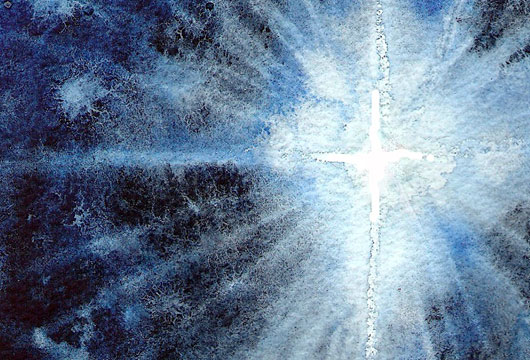
Christmas
Star, artwork by Ros Yates 2013
“Let there be Light”
Part
1: Reflections on Light, Color &
Our Relationship with God
by Ros
Yates
Genesis
1.1-3
In
the beginning God created the heavens
and the earth. 2 Now the earth was
formless and empty, darkness was over
the surface of the deep, and the Spirit
of God was hovering over the waters.
The story
of creation begins with darkness - the
absence of light.
Without
light there is no colour, nothing for our
eyes to respond to, no information, no
energy, no life on earth.
3 And God said, ‘Let
there be light,’ and there was light. 4
God saw that the light was good, and he
separated the light from the darkness. 5
God called the light ‘day’, and the
darkness he called ‘night’. And there was
evening, and there was morning – the first
day.
White
light contains all the colours of the
rainbow – and more beyond our eyes’ capacity
to see. When white light hits something it
reflects back light of different
wavelengths. The colour of the reflected
light is determined according to the nature
of the object.
Other colours are absorbed by the object’s
surface and so what we see is what is given
back.
I have
been struck by this physics lesson as a
metaphor for our lives lived in the light
of God. Each of us reflect God’s
light differently – our absorption and
refection spectrums are unique, everyone
giving off light differently according to
who we are and how we respond to God’s
light.
[Gundi expresses her
personality]
So God
shines his perfect light on each of us – in
our lives and worship we seek to give back
all we are – to love the Lord our God with
all our heart mind soul and strength, with
every colour of our being, every creative
quantum of energy.
So we all emanate a wonderful variety of
light; of personality, ideas, gifts,
offerings of love, but also weak spots,
needs, and opportunities to be
interdependent in community. None of
us fully reflect God’s light and that’s why
we need each other to complete the picture,
the body of Christ.
Colour theory includes the notion of
complimentary colours – those which are on
the opposite side of the colour wheel; red
and green, yellow and purple, orange and
blue. These colour combinations used
in a painting enhance one another;
Think about the red and green of
Christmas…….
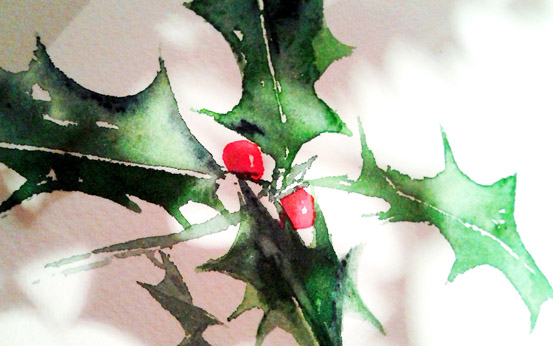
‘Holly and shadows’ Ros Yates
artwork 2012
……or the
purple and gold of royalty.
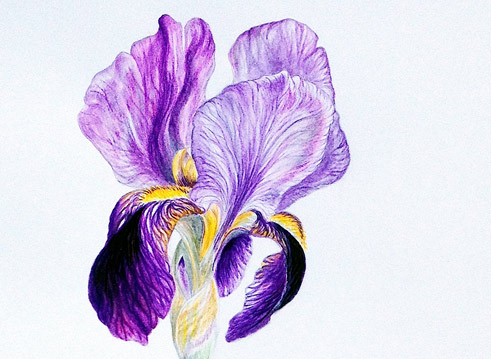
Iris – (detail) Ros Yates
artwork 2015
- The
blues and orange of a glorious sunset.
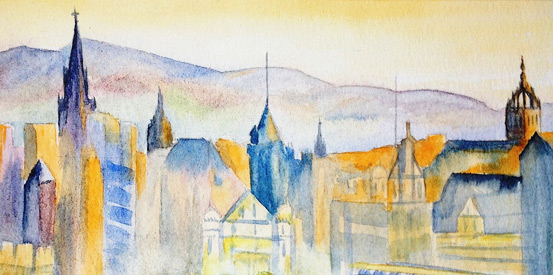
Edinburgh City Aglow – Ros Yates artwork
2015 - in memory of Iain Archibald
God’s light
is complete, white, pure, without gaps, no
colours missing or under-represented.
White speaks to us of purity, holiness,
glory, splendour, and revelation. But we
have stains, imperfections, mistakes, dirt,
flaws.
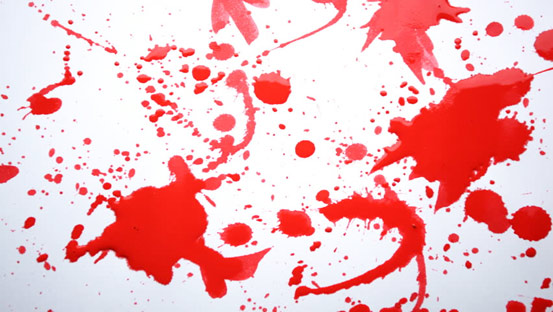
Isaiah 1v18
18 ‘Come now, let us
settle the matter,’ says the LORD.
‘Though your sins are like
scarlet, they shall be as white as
snow;
though they are red as
crimson, they shall be like wool.
-Think of laundry detergent adverts, or
those for stain removers.
- Think of snow – it makes everything look
clean and bright at first – till muddied
and trodden.
- Think of a blank canvas or piece of
paper – I choose one without marks,
undamaged, unused by others, ‘virgin’ –
kept clean WHITE and fresh for me.
- and think of what things make us impure,
spoilt; as individuals, or as a community,
and our need for forgiveness.
- but our destiny is to be the bride of
Christ – pure and spotless, made clean,
amazingly, by His blood shed for us.
Revelation 21. 1-5
Then I saw a new heaven and a new
earth, for the first heaven and the
first earth had passed away, and there
was no longer any sea. 2 I saw the
Holy City, the new Jerusalem, coming
down out of heaven from God, prepared
as a bride beautifully dressed for her
husband. 3 And I heard a loud voice
from the throne saying, ‘Look! God’s
dwelling-place is now among the
people, and he will dwell with them.
They will be his people, and God
himself will be with them and be their
God.
I shared this vision
with a school group of 11-14 year olds I
work with at a local High School.
We talked about being brides (it was
almost all girls!) and how we would
prepare for our wedding day.
We played that game
where one person is dressed like a bride
by the rest of the group in toilet roll
paper and white bin liners – we laughed,
we celebrated. The imperfections of the
dress design and the outcome didn’t
matter too much in the fun of the moment
– and so our imperfections will be
obliterated by the work of Christ our
bridegroom who laid down his life for us
and is coming to take us for his own.
Creative Worship Group, London –
dressing the bride January 2018
So one day we will be
robed in white and reflect all God’s glory
– but how do we get there? How can the
darkness be dispelled?
Christmas
Card 2013, Ros Yates artwork
The Word became flesh
and made his dwelling among us. We have seen
his glory, the glory of the one and only
Son, who came from the Father, full of grace
and truth.
John 1.14
‘The light shines in the
darkness and the darkness has not overcome
it.
John 1.5
It is darkness that is
associated with evil in the Bible– not the
colour black itself. Black things are
not evil or sinful. The beloved in the Song of
Solomon describes herself … ”I am black and
beautiful” (Songs 1.5) Things that are
black and shiny can be brighter than white
things hidden in shadow. It’s all about how
much light we reflect.
Black is never really
totally black. Even the darkest black paint
reflects some light – and if you dilute black
paint you will see that different blacks have
a colour to them. Paynes Grey is a
blueish black, others dilute to a shade of
brown, green or purple.
So with us, even the soul
that sits in darkness is capable of reflection
when God’s light and God’s water of life come
to show up our true colours.
However, there IS a black
invented by scientists call VantaBlack. It is
not a paint as such, but a coating of
miniscule tubes of carbon so small that most
light just cannot escape it. A wave of light
gets almost entirely trapped within it. Vanta
Black looks entirely matt and completely flat
like a black hole even if the surface is
crumpled. A 3D object coated with it
loses all appearance of form, depth, and
texture. This could be a symbol of the soul
that takes and takes and take but gives
nothing back - and that is dark indeed.
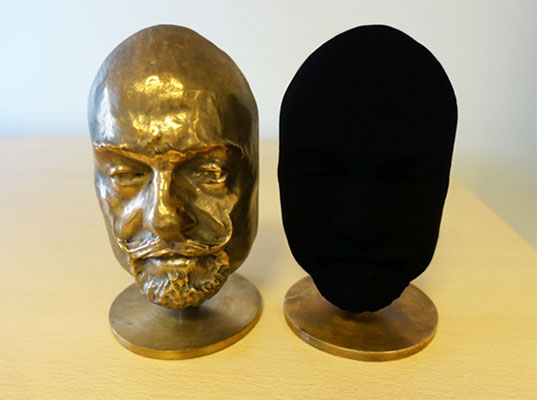
Bronze head
coated in Vanta Black
But
that is not how we were created.
We were not created black in the sense of
being unable to reflect God’s glory - In
our creatureliness we are gloriously brown
– formed from the dust of the earth. We
are of the earth; which is what the name
Adam means.
But we are more than earth’s dust; more
even, than the stardust that formed the
earth.
Genesis 2.7
Then the LORD God
formed a man[c] from the dust of the
ground and breathed into his nostrils
the breath of life, and the man became a
living being.
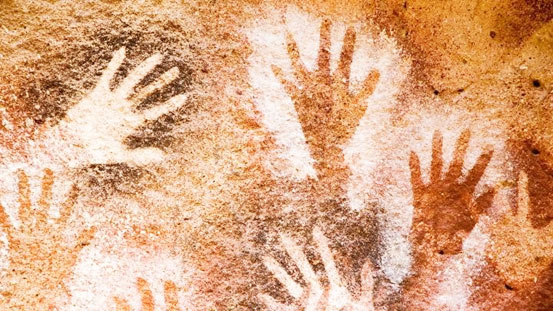 Early
human cave paintings Early
human cave paintings
We acknowledge our
creatureliness – our debt to our creator
who formed us in love and wisdom. It keeps
us humble to know we share this
materialism with the rest of
creation. Yet we are also spiritual
and created for a spiritual relationship
with God our Creator. His breath brings
life to us as children so clay shall take
form and live.
Isaiah 64;8
” O Lord you are our father. We are the
clay, you are the potter ; we are all
the work of your hand.
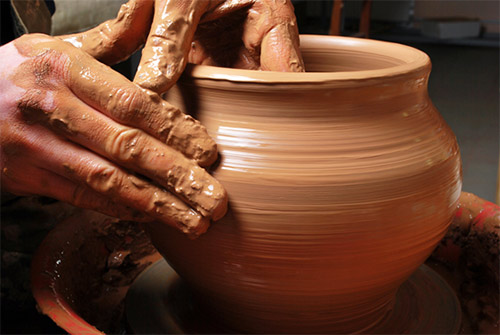
As the
work of God’s hands we were created to be
creative; made in His image we put our
imaginations to work. Humans have
always had that capacity – the first
paintings used the colours of the earth –
ochre – iron oxide – in shades of brown,
red, orange and yellow, and the white of
chalk or the black of ashes. Then came the
colours of natural minerals and organic
matter such as berries and other plant
dyes, or even blood. We have taken the
colours of the world that surround us and
brought them into our language as powerful
symbols, even before words and writing
came into being.
I will explore the language of colour in
the second part of my article, and
especially how colour is used in the Bible
and in our worship as well enriching our
daily lives – a walk through the spectrum
with Scripture.
Ros Yates is a member of
the Antioch ecumenical Christian
community in London. She has been
painting and drawing from an early age.
Having studied Biology and Theology she
is now an ordained Deacon in the Church
of England, a self-taught artist, and
mother of four children. Not
surprising then that themes of
creativity, spirituality and the natural
world are constantly interwoven in her
life and art.
She uses
art and crafts in prayer and Bible
study workshops with adults and
children. The natural world is a
constant course of inspiration. She
loves gardening and spending time at
The Royal Botanic Gardens at Kew in
London, the London Wetland Centre, and
holidays in Purbeck on the English
South Coast. All these find their way
into her art, as do the word-images
and parables of the Bible.
>
See other articles by Ros Yates
in Living
Bulwark
|
|
. |
|

